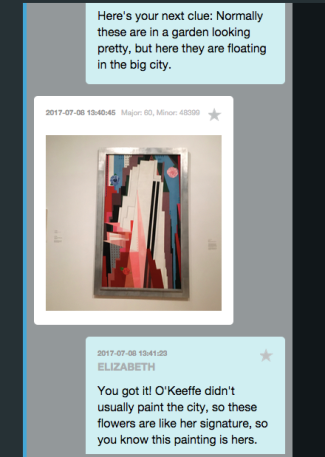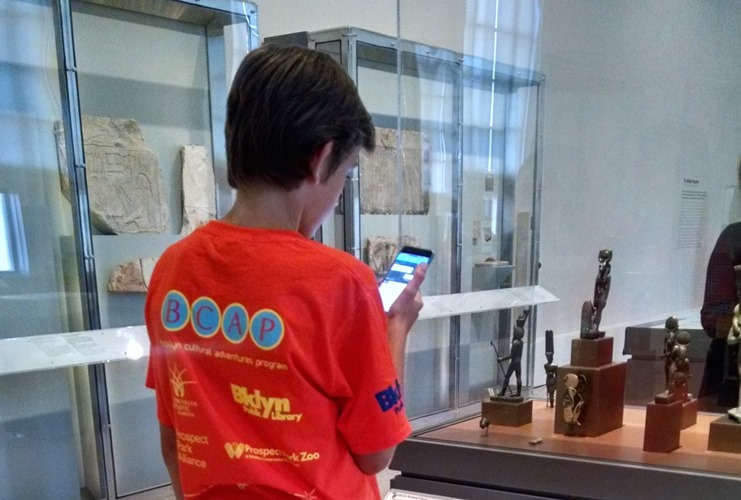ASK and Young Museum Visitors: On the Hunt
Sometimes we plan and execute ASK-related projects on a long timeline, but occasionally a project will happen organically and almost take us by surprise. Using ASK for group tours is an example of a project that took much planning, but resulted in little pick-up despite all that effort. However, our latest example of the latter type is our ASK scavenger hunt for young museum visitors, which has been growing in scale and detail over the past six months.

The Brooklyn Museum has a large audience of school-age visitors and their accompanying adults. Scavenger hunts have turned out to be an easy and dynamic way to engage them.
Last June, our colleagues in the Education Division invited ASK to participate in the annual “Bring the Cool” Family Festival, a day-long event organized in collaboration with local non-profit Cool Culture. The festival includes art-making activities and creative play for young children and their families, and it’s always a lot of fun, so we were happy to join in.
Since this year’s festival theme was “Color My World,” we put together a scavenger hunt with eight stops around our American Art galleries. We wrote a set of eight simple color-themed clues for eight varied works in the collection, from a Coclé gold disk embossed with a face to a nineteenth-century Brooklyn landscape painting. When users downloaded the app at the hunt’s starting point, we could guide them exclusively through our ASK exchange in either English or Spanish. We invited them to send photos of the works and to share personal answers to related questions.
The kids who tried the scavenger hunt seemed to enjoy it so much that we thought it was something we should try again. Meanwhile, as we moved into the summer and schools let out for vacation, our ASK Ambassadors reported an increasing number of museum visitors asking for “something to do with children” during their visit. Responding quickly to this seasonal shift in attendance, the ASK team invited younger children to try the American hunt but also started compiling clues for favorite objects around the rest of the Museum.

Attendance was high in “Georgia O’Keeffe: Modern Living” during the summer and the ASK team came up with rhyming clues to interest young visitors in the show.
These family- and child-oriented chats turned out to be really popular. We chatted frequently with young museumgoers in the special exhibitions “Georgia O’Keeffe: Living Modern” and “We Wanted a Revolution: Black Radical Woman 1965-85” as well as the permanent galleries for Ancient Egyptian Art, Decorative Arts, and more.
As the opening date for the fall exhibition “Soulful Creatures: Animal Mummies in Ancient Egypt” approached, we were hearing more and more conversation around the Museum about ways to engage families and children with this show. We offered to create a hunt itinerary specifically for “Soulful Creatures,” focusing even more on providing interesting educational facts as follow-ups to the clues.

Several children of staff members took time from a summer afternoon to test an early version of our “Soulful Creatures” hunt in the Egyptian galleries.
Since “Soulful Creatures” wasn’t installed yet, we decided to “beta-test” our script in the permanent Egyptian galleries, with the valuable assistance of several staff members’ children. These young volunteers did a run-through of the hunt and chatted with us afterwards. They gave extremely helpful feedback about the instructions they’d received, the difficulty level of the questions, and the choice and spacing of the objects. They also had some great questions about ASK in general, and we took notes for any future project involving younger visitors.
When “Soulful Creatures” opened on September 29, we were ready to go. The ASK team had selected ten objects in the show and written a script with two sets of clues, one for beginner readers (about ages 4-7) and one for more advanced learners (ages 8-11), as well as entertaining facts to share about each object once the user had located it. Our ASK Ambassadors were prepared to pitch the hunt to visitors entering the show and to provide assistance with downloads and getting started.
So far, we’ve guided young “mummy-hunters” ranging in age from four through twelve years old, and almost half the hunts have included two or more children together. Some users completed all ten clues, while others (depending on available time or attention span) were satisfied after finding four or five works. Our Visitor Services department is also offering a family packet for this exhibition, so various options are available for kids—we’ve just asked our ASK Ambassadors to pitch the ASK hunt only to families who haven’t already taken advantage of the packet.

We’re often happily surprised when our young users include themselves in their “I found it!” photos.
Like all our work, this process of shaping and expanding ASK scavenger hunts has been a team project, and it’s turned out to be a team favorite as well as a popular option with visitors. We’ll be thinking about new hunt ideas for the new year as we continue to connect with some of our youngest museum visitors.

Jessica Murphy, Manager of Visitor Engagement, joined the Brooklyn Museum in 2015 as a member of the ASK team. In her current position she leads the team in their interactions with the Museum’s visitors through the ASK app and coordinates their ongoing training and development. Jessica received her B.A. from Fordham University and her M.A. and Ph.D. in Art History (with a concentration in American Art) from the University of Delaware. She previously worked as Research Associate at the Metropolitan Museum of Art (contributing to exhibitions and publication such as “Alfred Stieglitz and His Artists: Matisse to O’Keeffe” and “The American West in Bronze”), as Contractual Educator at the Met, and as Curatorial Assistant at the Philadelphia Museum of Art. She has also worked as a freelance writer on cultural topics. She welcomes any opportunity, in any medium, to connect people and art.



Masscv - 5 years ago
Good article! It was an interesting story.